|

 Up
Up 
 1901 Wright
1901 Wright
Glider 
(You are here.)



  Need
to Need
to
find your
bearings?
Try
these
navigation aids:
If
this is your first
visit, please stop by:
Something
to share?
Please:



|
|
Available in Française, Español, Português, Deutsch, Россию,
中文,
日本, and others.
 he
Wrights
flew their second glider several hundred times at Kitty Hawk in July and
August 1901, making flights that ranged from 50 to 400 feet (15 to
122 meters). It flew modestly better than their 1900 glider, but it
was still a disappointment to the Wright brothers. It was much less
responsive to its controls than their first (1900) glider. And even
though it supported their weight well enough to make some reasonably
long glides, it still did not produce the amount of lift Wilbur's
calculations had predicted. he
Wrights
flew their second glider several hundred times at Kitty Hawk in July and
August 1901, making flights that ranged from 50 to 400 feet (15 to
122 meters). It flew modestly better than their 1900 glider, but it
was still a disappointment to the Wright brothers. It was much less
responsive to its controls than their first (1900) glider. And even
though it supported their weight well enough to make some reasonably
long glides, it still did not produce the amount of lift Wilbur's
calculations had predicted. The 1901 Wright Glider specifications:
- 22 ft (6.7 m) wingspan
- 7 ft (2.1 m) chord
- 1/12 camber, later reduced to 1/19
- 4.8 ft (1.5 m) separation
- 290 sq ft (26.9 sq m) wing area
- 18 sq ft (1.7 sq m) front elevator area
- 14 ft (4.3 m) length
- 98 lbs (44.5 kg) weight.
There was no vertical rudder or stabilizer.
Believing
the inadequate lift of the 1900 glider to be its shallow 1/23 camber, they initially built the
1901 glider with the 1/12 camber recommended by Lilienthal. They also
greatly increased the size of the wings. Sluggish performance and
problems with control caused
them to change the camber to 1/19, but the low aspect (wingspan to chord)
ratio of just 3:1 still
caused marginal performance. They found a slight anhedral (drooping wing tips) provided
resistance to side gusts. Unstable anhedral wings were characteristic on most subsequent
Wright airplanes.
The 1901 Wright glider was a frustration to the Wright Brothers. On the way home from
Kitty Hawk, a sad and discouraged Wilbur is said to have remarked to Orville that although
he still believed man would fly, it would not be in his lifetime. The
glider remained stored in camp at Kitty Hawk until 1902 when the brothers scavenged its uprights for their
third (1902) glider, and destroyed the remainder.
See more images of the 1901 Wright Glider in our
Virtual Hangar.
References:
- McFarland, 1953, pp 1184-5; plates 19-29, 35.
- Wright, Orville in Kelly, 1953, p 15-17.
- McFarland, Marvin W. (ed) The papers of Wilbur and Orville Wright. McGraw-Hill
Book Co., New York, 1953, pp 1184-5; plates 19-29, 35.
- Wright, Orville, "How We Invented the Airplane." (from depositions in
Montgomery vs. U.S. 13 Jan 20 and 2 Feb 21; in Kelly, Fred C. (editor) How We Invented the
Airplane, an Illustrated History. Dover Publications, New York, 1953, p 15-17)
[Submitted by Joe W. McDaniel]
|

At the time that it was built, the 1901 Wright
glider was the largest soaring machine that anyone had attempted to
fly.
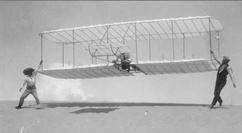
The Wrights launched the glider with the assistance of Dan Tate, a
local "Banker," as the residents of the North Carolina Outerbanks
called themselves. At this point, Wilbur (center) was still doing
all the flying. Orville (right) assisted in launches.
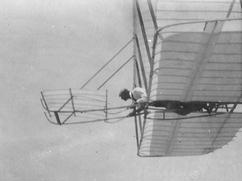
A close up of Wilbur in flight.
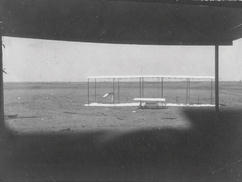
The 1901 Wright glider resting on the sand
outside the shed the Wrights built to house it.
|
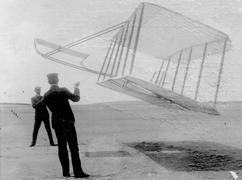
As with the 1900 glider, the Wrights few the 1901 glider first as a
kite to measure the lift and drag its wings produced.
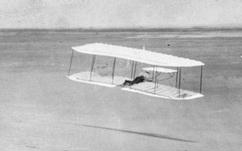
The 1901 Wright glider in flight. It was stable enough to make
glides up to 400 ft (122 m), but its response to it controls was
sluggish and sometimes unpredictable.
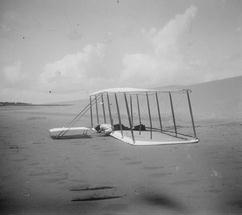
The 1901 glider landed. No the skids marks in the sand behind the
glider -- the "roll-out" was very short; the glider came to a stop
quickly after it touched down.
|